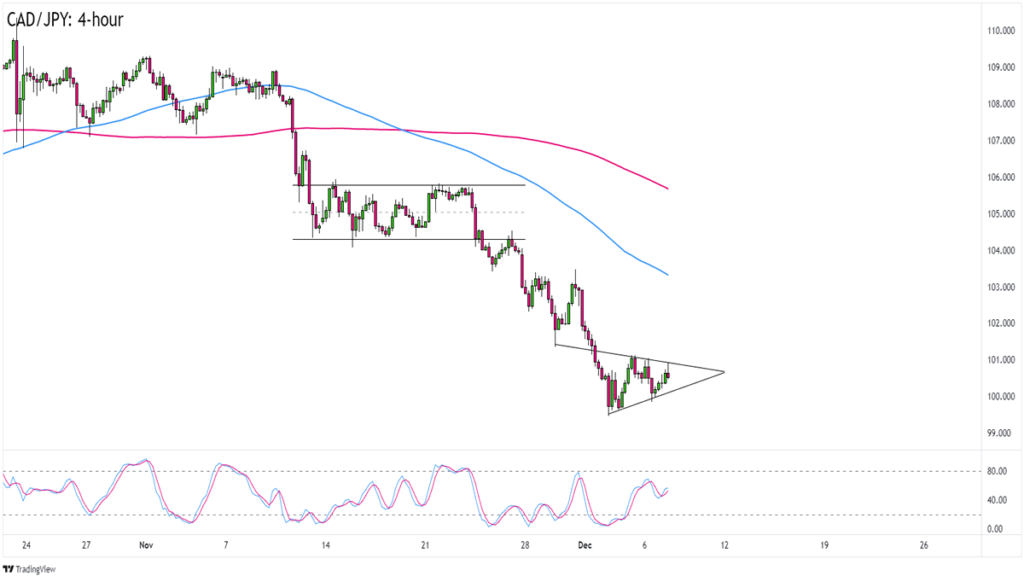[ad_1]
We got a lot of risk-off vibes this week as recession fears continued to grow in the minds of traders, as well as surprise inflation updates keeping traders on their toes with regards to central bank expectations.
The Swiss franc was the big winner this week, while its usual “safe haven” buddy, the Japanese yen, fell to last place on speculation of potential policy shifts from the BOJ ahead.
Notable News & Economic Updates:
China services activity index shrunk from 48.4 in October to six-month low of 46.7 in November
J.P.Morgan Global PMI Output Index fell to 48.0 in November from 49.0 in October; Global Services Business Activity Index fell to 48.1 in November from 49.2 in October
According to a letter from its leaders on Wednesday, the Senate Banking Committee wants Sam Bankman-Fried to personally testify before it next week to investigate the collapse of FTX and will subpoena him if he refuses.
EIA crude oil inventories fell by 5.2M barrels vs. projected reduction of 3.5M barrels
China’s exports (-8.7% y/y) and imports (-10.6% y/y) shrank at their steepest pace in at least 2.5 years
China announced on Wednesday that asymptomatic COVID-19 cases and people with mild symptoms can now quarantine at home
Ethereum devs announced on Thursday that the “Shanghai” hard fork’s projected release date will be in March 2023. This upgrade will add the EIP 4895 code, which will allow withdrawals of staked ether (ETH) from the Beacon Chain.
Shanghai to remove COVID test requirement for food and entertainment venues; “Hong Kong is expected to loosen up COVID restrictions on isolation and masking
More than 14,000 barrels of crude oil leaked into a creek in Kansas, prompting Canadian company TC Energy to shut down its Keystone pipeline in the U.S.
Intermarket Weekly Recap
The focus this week continued to be on 2023 recession speculation and inflation updates, but it looks like recession fears may have jumped inflation concerns as the main focus. This was evidenced by both dollar strength, and the fall in bond yields/rise in bond prices, signaling traders are finally to take on some bonds to hedge against a potential recessionary environment ahead.
We also saw a steady drop in risk assets, basically from the get-go, with the most notable move in oil prices as WTI crude nearly touched the $70 handle before the weekend. The dramatic fall in oil was especially surprising given the fall in inventories and news of an oil leak in the U.S., making the argument that traders are focused on the lack of oil demand a 2023 recession may bring.
And it’s no wonder that recession fears have grown this week as we saw a steady stream of weakening global business survey data, potentially signaling further weakness in economic updates in the months ahead. Chinese and European surveys continued to show contractionary conditions, while the U.K. showed that it’s probably not too far away from falling into that environment.
This U.S. was an outlier this week in that regard as it showed better-than-expected business survey data, and when coupled with the surprise tick higher in U.S. producer prices and factory orders, it’s likely traders will continue to have to price in the probability of interest rates rising and staying relatively high for the time being. Or to put it simply, no Fed pivot anytime soon, which was solidified further on Friday after a stronger-than-expected U.S. PPI number.
In the forex space, price action was relatively mixed this week as individual currency/country stories seemed to be slightly more in play than macro factors. Most notable were the “safe haven” currencies.
First the Swiss franc took the top spot, not an unexpected outcome given the risk-off vibes, and possibly a technical bounce from recent weakness against the majors. It’s also possible the franc tracked the euro this week, which saw some gains, possibly on the back of mostly better-than-expected data from the Euro area.
But what was unexpected was the fall in the Japanese yen, which tends to benefit in a risk-off environment. It’s likely that after last month’s Japanese core inflation read that hit a 40-year high and above 2.0% target rate, traders may now be more focused on a potential shift in BOJ policy than the macro environment. The likely argument is that a move away from an ultra-loose monetary policies like Yield Curve Control could severely slow the Japanese economy.
USD Pairs

Overlay of USD Pairs: 1-Hour Forex Chart
ISM Services Index in November: 56.5 from 54.4 in October
U.S. Factory Orders in October: 1.0% m/m vs. 0.3% m/m in September
U.S. Trade Deficit: $78.2 billion in October vs. $78.1 billion in September
U.S. Consumer Credit in October came in below expectations at $27.1B but above the previous month, which was revised higher to $25.8B
Weekly Initial U.S. jobless claims rose to 230K in the week ending December 3rd vs. 226K the previous week.
U.S. Producer Price Index for November: +0.3% m/m +0.3% m/m previous; core PPI at +0.4%
Preliminary U.S. consumer sentiment index for December: 59.1 vs. 56.8, above expectations of 56.9
GBP Pairs

Overlay of GBP Pairs: 1-Hour Forex Chart
UK new car sales up more than 20% in November
U.K. BRC retail sales monitor rose from 1.2% to 4.1% y/y in Nov
U.K. Construction PMI for November: 50.4 vs. 53.2 in October
Halifax: U.K. house prices fall 2.3% from October to November, the fastest rate in 14 years
U.K. RICS survey showed most widespread drop in house prices since May 2020
EUR Pairs

Overlay of EUR Pairs: 1-Hour Forex Chart
ECB’s Lagarde says inflation hasn’t peaked, may surprise to the upside
Eurozone Services Business Activity Index was at 48.5 in November vs. 48.6 in October
France Services PMI for November: 49.3 from 51.7 in October
Germany Services PMI for November: 46.1 vs. 46.5 in October; prices remain elevated
The volume of retail trade in the euro area was down by -1.8% m/m in October 2022 and by -1.7% m/m in the European Union
German Oct factory orders rebounded by 0.8% m/m vs. projected 0.2% uptick
Sentix Investor Confidence improved to -21.0 in Dec. vs. -27.1 forecast; the expectations index rose to -22.0 vs. -32.3 previous
Germany industrial production declined by 0.1% in Oct (vs. 1.1% in Sept) as high energy prices take toll
In Q3 2022, Euro area GDP grew by a seasonally adjusted +0.3% q/q; employment was up +0.3% q/q
CHF Pairs

Overlay of CHF Pairs: 1-Hour Forex Chart
Swiss jobless rate rose from 1.9% to 2.0% as expected in November, below 2.1% forecast
CAD Pairs

Overlay of CAD Pairs: 1-Hour Forex Chart
Canada Ivey PMI: 51.4 in November vs. 50.1 in October; Employment Index ticks down to 54.3; Prices Index decreased from 69.8 to 63.5
The value of Canada’s merchandise exports increased by 1.5% in October, while the value of its imports rose by 0.6%. As a direct consequence of this, the merchandise trade surplus that Canada enjoyed with the rest of the world increased from $607M in September to $1.2B in October.
Bank of Canada raised the overnight interest rate by 50 bps to 4.25% on Wednesday; hinted that the they may be nearing the end of the tightening cycle
Canada Capacity Utilization Rate for Q3: 82.6% vs. 82.8% previous
NZD Pairs

Overlay of NZD Pairs: 1-Hour Forex Chart
Global Daily Trade Price Index rose +0.6% to $3.60 since the last auction
NZ manufacturing sales improve from -3.2% to 5.1% q/q in Q3 2022
NZ credit card spending up by 0.3% from October to November as consumers spend more on essentials
AUD Pairs

Overlay of AUD Pairs: 1-Hour Forex Chart
AU construction contraction improves from 43.3 to 48.2 in November
AU MI inflation gauge accelerates from 0.4% to a four-month high of 1.0% in November
RBA hiked interest rates by 25bp from 2.85% to 3.10% as expected
Australian Q3 current account balance showed 2.3B AUD deficit vs. projected 5.9B AUD surplus
AIG PMI: Australia’s services sector shrunk from 47.7 to 45.6 in November on weakening demand
Australia’s GDP grew 0.6% in September quarter and 5.9% annually as economy recovered from Covid lockdowns
Australia Trade Balance for October: surplus of A$12.22B, below September’s surplus read of A$12.44B
JPY Pairs

Overlay of Inverted JPY Pairs: 1-Hour Forex Chart
Japanese Oct household spending down from 2.3% to 1.2% y/y vs. 0.9% forecast; Real wages fell -2.6% y/y
Japan’s Economy Watchers sentiment index down from 49.9 to 48.1 in Nov.
The recent weakness of the yen & rising oil prices caused Japan to record its first current account deficit in nine months in October, the Finance Ministry reported on Thursday. The shortfall was ¥64.1B ($470 million).
Japan GDP for Q3 2022 was revised higher to -0.2% q/q vs. -0.3% q/q previous
[ad_2]
Source link



